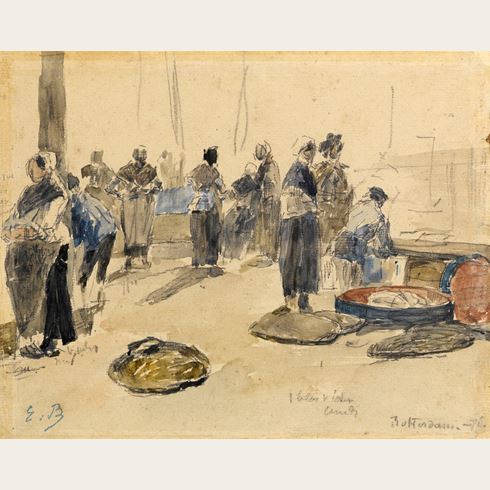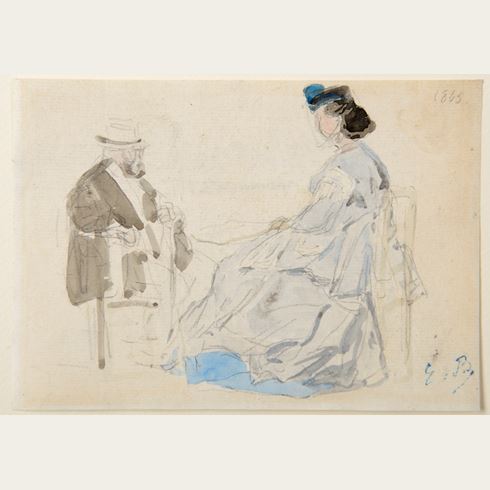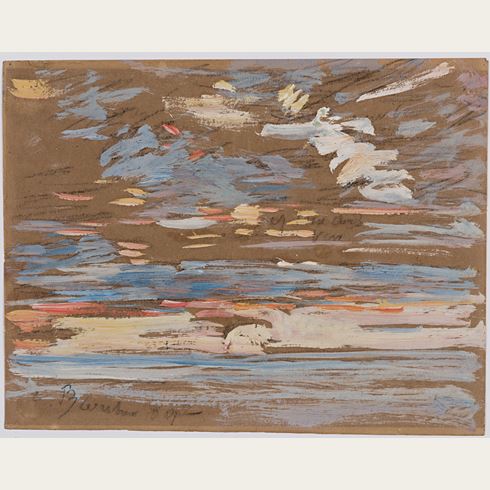Eugène BOUDIN
(Honfleur 1824 - Deauville 1898)
Crinolines
Sold
Watercolour over an underdrawing in pencil.
Stamped with the atelier stamp E.B. (Lugt 828) and dated 1865 at the lower right.
Variously inscribed with colour notes (rouge, bleu, gris, violet, etc.) in pencil.
136 x 244 mm. (5 3/8 x 9 5/8 in.) [sight]
Stamped with the atelier stamp E.B. (Lugt 828) and dated 1865 at the lower right.
Variously inscribed with colour notes (rouge, bleu, gris, violet, etc.) in pencil.
136 x 244 mm. (5 3/8 x 9 5/8 in.) [sight]
Throughout his career, Eugène Boudin was drawn to the seaside resort towns of Trouville and Deauville, on the Normandy coast. South of Le Havre and originally a fisherman’s village, Trouville had been transformed into a resort destination around 1848. With the opening of rail connections in 1860, the town oversaw a spurt in growth to accommodate the crowds of bourgeoisie who flocked to the seaside from Paris and elsewhere, with the establishment of luxury hotels, villas, casinos and a racecourse. Boudin rented a house in Trouville each summer and painted countless pictures of people on its beaches, as well as views of the quay, the fish market and the outskirts of the town.
Boudin’s depictions of elegant city dwellers as holidaymakers on the beach of Trouville, with a particular emphasis on fashionable women in crinoline dresses, date mainly from the 1860’s. He painted some three hundred canvases of this subject throughout his career, and these works soon proved very popular with collectors. As the artist wrote to a friend in 1863, ‘They love my little ladies on the beach, and some people say that there’s a thread of gold to exploit there.’ The critic Jules Castagnary noted that ‘M. Boudin has made the Norman coast his speciality. He has even invented a genre of marine that belongs only to him and which consists of painting, as well as the beach, all the beautiful, exotic society that foregathers in the summer in our seaside towns. It is seen from far away, but what delicacy and vivacity there is in these tiny figures. How well they look in their picturesque milieu, and how this, gathered together, forms a picture: the sky rolls its clouds, the swell rumbles as it rises, the breeze that blows teases the frills and skirts, this is the sea, and one can almost breathe the salty air.’
The artist’s biographer Gérard Jean-Aubry has written that ‘Boudin executed a number of pencil sketches of elegant women and fashionable people on the beach. The colours are indicated by watercolour washes, or simply by written notes. These charming sketches form part of the same group as Boudin’s studies of fishermen on the quaysides, or boats in the harbours, but apart from this they constitute as artistically valuable a documentation of the fashions of an epoch as those of Constantin Guys. It is regrettable that all these sketches have been scattered, since a choice of them would have composed a charming album of feminine fashion on the beaches during the heyday of the Second Empire.’
A dated watercolour such as the present sheet was, in all likelihood, intended to have been sold. That many of these watercolours of beach scenes were indeed sold by the artist to collectors - mainly during a period of seven years in the 1860’s - is seen in the fact that relatively few such studies were left in the Boudin’s studio at his death. Comparable sketches include several among the large group of drawings by Boudin in the Louvre, while similar watercolours are in the Musée d’Art Moderne André Malraux in Le Havre and the Garman-Ryan Collection at the New Art Gallery Walsall.
One recent scholar has noted of Boudin’s watercolours of the 1860’s that ‘A medium new to him, watercolour was perfectly suited to his subject, the transparency of the medium enhancing the impression of light. Boudin moved out from the shadows to concentrate his attentions on reflections: fine, brightly coloured fabrics on sand flooded with sun, and the sky on the sea. Everything became light. Impressionism was on its way.’
Boudin’s depictions of elegant city dwellers as holidaymakers on the beach of Trouville, with a particular emphasis on fashionable women in crinoline dresses, date mainly from the 1860’s. He painted some three hundred canvases of this subject throughout his career, and these works soon proved very popular with collectors. As the artist wrote to a friend in 1863, ‘They love my little ladies on the beach, and some people say that there’s a thread of gold to exploit there.’ The critic Jules Castagnary noted that ‘M. Boudin has made the Norman coast his speciality. He has even invented a genre of marine that belongs only to him and which consists of painting, as well as the beach, all the beautiful, exotic society that foregathers in the summer in our seaside towns. It is seen from far away, but what delicacy and vivacity there is in these tiny figures. How well they look in their picturesque milieu, and how this, gathered together, forms a picture: the sky rolls its clouds, the swell rumbles as it rises, the breeze that blows teases the frills and skirts, this is the sea, and one can almost breathe the salty air.’
The artist’s biographer Gérard Jean-Aubry has written that ‘Boudin executed a number of pencil sketches of elegant women and fashionable people on the beach. The colours are indicated by watercolour washes, or simply by written notes. These charming sketches form part of the same group as Boudin’s studies of fishermen on the quaysides, or boats in the harbours, but apart from this they constitute as artistically valuable a documentation of the fashions of an epoch as those of Constantin Guys. It is regrettable that all these sketches have been scattered, since a choice of them would have composed a charming album of feminine fashion on the beaches during the heyday of the Second Empire.’
A dated watercolour such as the present sheet was, in all likelihood, intended to have been sold. That many of these watercolours of beach scenes were indeed sold by the artist to collectors - mainly during a period of seven years in the 1860’s - is seen in the fact that relatively few such studies were left in the Boudin’s studio at his death. Comparable sketches include several among the large group of drawings by Boudin in the Louvre, while similar watercolours are in the Musée d’Art Moderne André Malraux in Le Havre and the Garman-Ryan Collection at the New Art Gallery Walsall.
One recent scholar has noted of Boudin’s watercolours of the 1860’s that ‘A medium new to him, watercolour was perfectly suited to his subject, the transparency of the medium enhancing the impression of light. Boudin moved out from the shadows to concentrate his attentions on reflections: fine, brightly coloured fabrics on sand flooded with sun, and the sky on the sea. Everything became light. Impressionism was on its way.’
The son of a sailor, Louis-Eugène Boudin established a small stationery and framing shop in the port city of Le Havre. Encouraged by some of the artists living or working in the area, whose work he sometimes exhibited in his shop, he took up painting himself in 1847. By the early 1850’s he had established a modest career as a landscape painter, working in Le Havre, Rouen, Honfleur and Paris. Praised by contemporaries such as the critic Charles Baudelaire, Boudin began painting marine scenes that attracted much favourable comment when he began exhibiting regularly at the Salon from 1859 onwards. He travelled extensively around France, Belgium and the Netherlands, and made yearly visits to favourite sites in Normandy and Brittany, in particular the fashionable seaside resorts of Deauville and Trouville. Much of Boudin’s work was small in scale, and was shown both in Paris and in provincial exhibitions around the country. He found a ready market for his paintings and, from 1881 onwards, enjoyed a fruitful relationship with the dealer Paul Durand-Ruel, who sold his works in France and in America.
Boudin's paintings and lively watercolours, with their interest in capturing effects of light and colour, were an important early influence on Claude Monet, who was his pupil. Some six thousand drawings, watercolours and oil sketches – most of the contents of Boudin’s studio at his death - are today in the Louvre, while other significant groups of drawings and watercolours were given by the artist or his descendants to the museums of Le Havre and Honfleur.
Provenance
The studio of the artist
Probably the Boudin atelier sale, Paris, Hôtel Drouot, 20-21 March 1899
Private collection, Connecticut.









